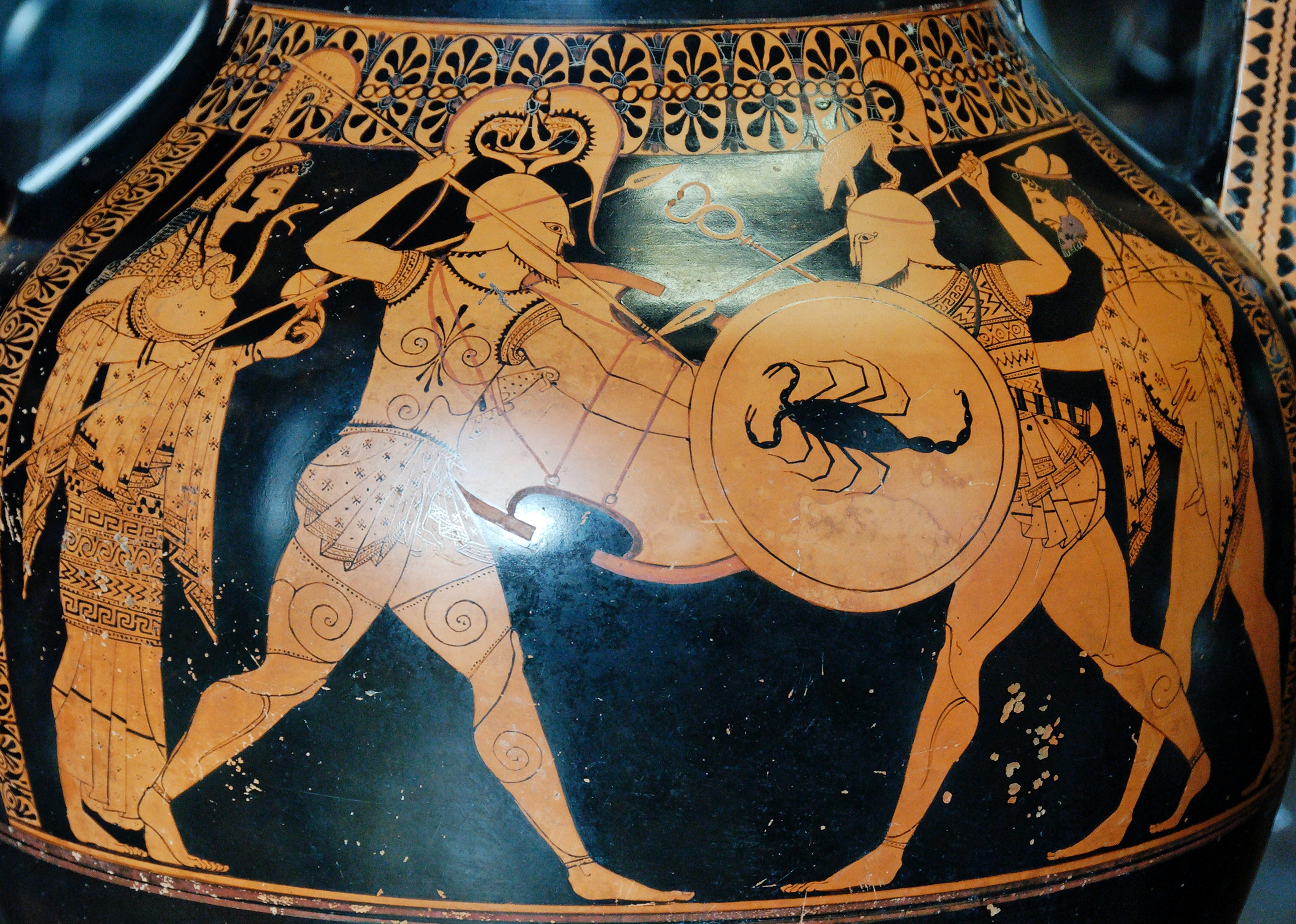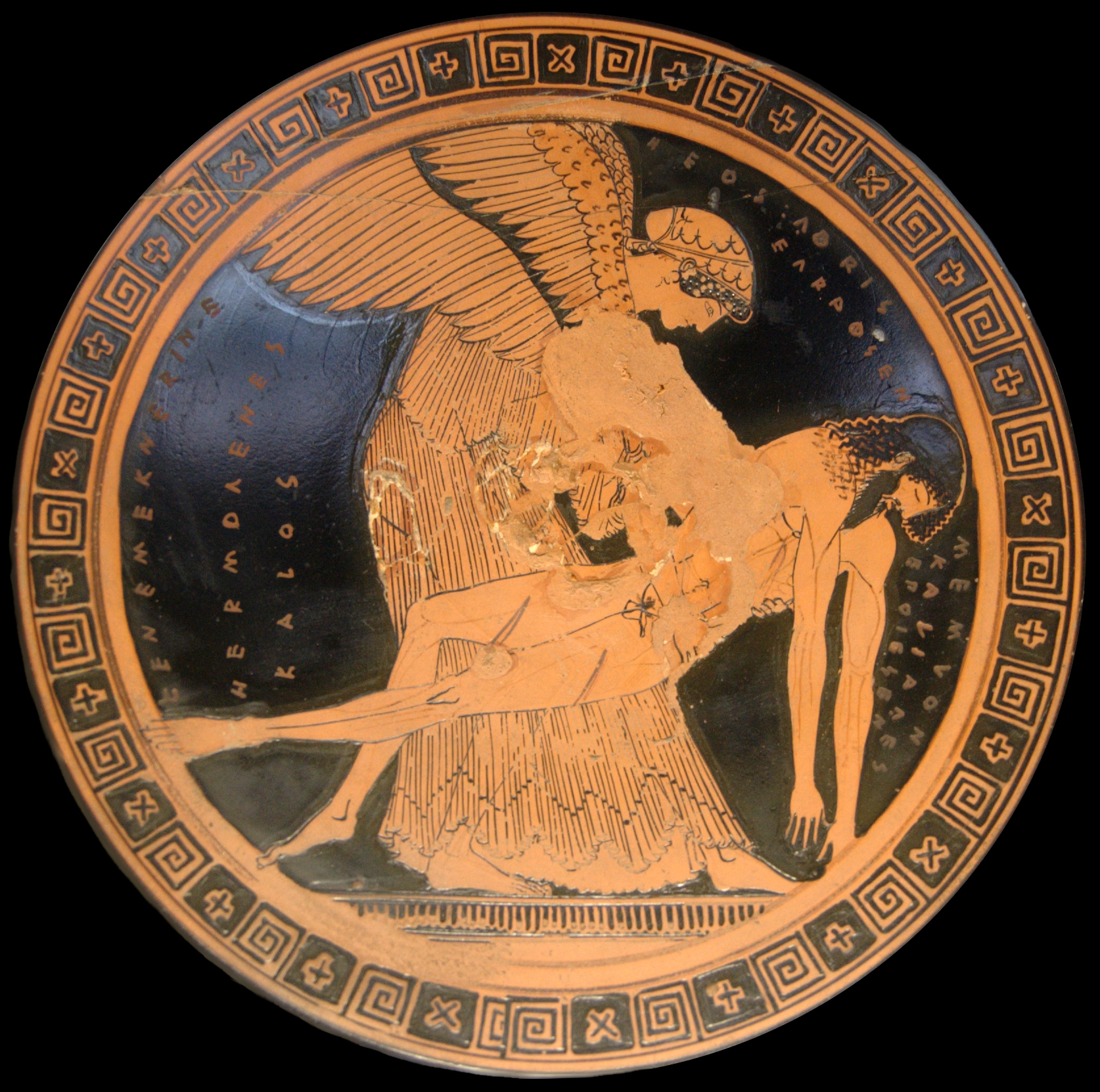|
Three Line Group
The term Three Line Group describes a group of Attic black-figure vase painters, as well as a type of vase. They belong to the last quarter of the sixth century BC. The group's conventional name is based on its habit of separating the individual decorative stripes on small-format neck amphorae with three separating lines. The group produces work of increasingly worse quality during its period activity. Its decorations are rarely better than poor. In spite of the limited quality, their work reminded John Beazley of the Andokides Painter. The group's vases are often extensively inscribed. Apart from names of depicted figures, they can also bear ''kalos'' inscriptions for ''Onetorides'' or ''Hippokrates''. Bibliography * John Beazley Sir John Davidson Beazley, (; 13 September 1885 – 6 May 1970) was a British classical archaeologist and art historian, known for his classification of Attic vases by artistic style. He was Professor of Classical Archaeology and Art at the Un ... [...More Info...] [...Related Items...] OR: [Wikipedia] [Google] [Baidu] |
Attica
Attica ( el, Αττική, Ancient Greek ''Attikḗ'' or , or ), or the Attic Peninsula, is a historical region that encompasses the city of Athens, the capital of Greece and its countryside. It is a peninsula projecting into the Aegean Sea, bordering on Boeotia to the north and Megaris to the west. The southern tip of the peninsula, known as Laurion, was an important mining region. The history of Attica is tightly linked with that of Athens, and specifically the Golden Age of Athens during the classical period. Ancient Attica ( Athens city-state) was divided into demoi or municipalities from the reform of Cleisthenes in 508/7 BC, grouped into three zones: urban (''astu'') in the region of Athens main city and Piraeus (port of Athens), coastal (''paralia'') along the coastline and inland (''mesogeia'') in the interior. The modern administrative region of Attica is more extensive than the historical region and includes Megaris as part of the regional unit West A ... [...More Info...] [...Related Items...] OR: [Wikipedia] [Google] [Baidu] |
Black-figure Vase Painting
Black-figure pottery painting, also known as the black-figure style or black-figure ceramic ( grc, , }), is one of the styles of painting on antique Greek vases. It was especially common between the 7th and 5th centuries BCE, although there are specimens dating as late as the 2nd century BCE. Stylistically it can be distinguished from the preceding orientalizing period and the subsequent red-figure pottery style. Figures and ornaments were painted on the body of the vessel using shapes and colors reminiscent of silhouettes. Delicate contours were incised into the paint before firing, and details could be reinforced and highlighted with opaque colors, usually white and red. The principal centers for this style were initially the commercial hub Corinth, and later Athens. Other important production sites are known to have been in Laconia, Boeotia, eastern Greece, and Italy. Particularly in Italy individual styles developed which were at least in part intended for the Etruscan ... [...More Info...] [...Related Items...] OR: [Wikipedia] [Google] [Baidu] |
Neck Amphora
An amphora (; grc, ἀμφορεύς, ''amphoreús''; English plural: amphorae or amphoras) is a type of container with a pointed bottom and characteristic shape and size which fit tightly (and therefore safely) against each other in storage rooms and packages, tied together with rope and delivered by land or sea. The size and shape have been determined from at least as early as the Neolithic Period. Amphorae were used in vast numbers for the transport and storage of various products, both liquid and dry, but mostly for wine. They are most often ceramic, but examples in metals and other materials have been found. Versions of the amphorae were one of many shapes used in Ancient Greek vase painting. The amphora complements a vase, the pithos, which makes available capacities between one-half and two and one-half tons. In contrast, the amphora holds under a half-ton, typically less than . The bodies of the two types have similar shapes. Where the pithos may have multiple small ... [...More Info...] [...Related Items...] OR: [Wikipedia] [Google] [Baidu] |
John Beazley
Sir John Davidson Beazley, (; 13 September 1885 – 6 May 1970) was a British classical archaeologist and art historian, known for his classification of Attic vases by artistic style. He was Professor of Classical Archaeology and Art at the University of Oxford from 1925 to 1956. Early life Beazley was born in Glasgow, Scotland on 13 September 1885, to Mark John Murray Beazley (died 1940) and Mary Catherine Beazley née Davidson (died 1918). He was educated at King Edward VI School, Southampton and Christ's Hospital, Sussex. He then attended Balliol College, Oxford where he read Literae Humaniores: he received firsts in both Mods and Greats. He graduated with a Bachelor of Arts (BA) degree in 1907. While at Oxford he became a close friend of the poet James Elroy Flecker. Academic career After graduating, Beazley spent time at the British School at Athens. He then returned to University of Oxford as a student (equivalent to fellow) and tutor in Classics at Christ Church. ... [...More Info...] [...Related Items...] OR: [Wikipedia] [Google] [Baidu] |
Andokides Painter
Andokides was an ancient Athenian vase painter, active from approximately 530 to 515 B.C. His work is unsigned and his true name unknown. He was identified as a unique artistic personality through stylistic traits found in common among several paintings. This corpus was then attributed by John D. Beazley to the Andokides Painter, a name derived from the potter Andokides, whose signature appears on several of the vases bearing the painter's work. He is often credited with being the originator of the red-figure vase painting technique. To be sure, he is certainly one of the earliest painters to work in the style. In total, fourteen amphorae and two cups are attributed to his hand. Six of the amphorae are " bilingual", meaning they display both red-figure and black-figure scenes. Biography Several details regarding the artistic biography of the Andokides Painter have been suggested through connoisseurial studies of his work. As mentioned, he is widely thought to be the creator of ... [...More Info...] [...Related Items...] OR: [Wikipedia] [Google] [Baidu] |
Kalos Inscription
A ''kalos'' inscription (''καλός'') is a form of epigraph found on Attic vases and graffiti in antiquity, mainly during the Classical period from 550 to 450 BC. The word ''kalos'' (καλός) means "beautiful", and in the inscriptions it had an erotic connotation. Overview The ''kalos'' inscription is typically found on vessels used for a symposium. The scenes that accompany the inscription vary, and include athletic exercises and myths. Some inscriptions are generic, reading only "the boy is beautiful" (ὁ παῖς καλός). The inscription more often took the form of the beloved's name, in the nominative singular, followed by "kalos" (''X kalos'', i.e. "X is beautiful"). The beloved is most often a male youth, but a few times girls or women were spoken of as ''kalē'' (καλή). In one early cataloging of the inscriptions, among the individuals labeled as beautiful were 30 women and girls, and 528 youths. Male names outnumber female by more than twenty to one. At ... [...More Info...] [...Related Items...] OR: [Wikipedia] [Google] [Baidu] |
John Boardman (art Historian)
Sir John Boardman, (; born 20 August 1927) is a classical archaeologist and art historian. He has been described as "Britain's most distinguished historian of ancient Greek art." Biography John Boardman was educated at Chigwell School (1938–1945); then Magdalene College, Cambridge, where he read Classics beginning in 1945. After completing two years' national service in the Intelligence Corps he spent three years in Greece, from 1952 to 1955, as the Assistant Director of the British School at Athens. He married Sheila Stanford in 1952 (d. 2005), and has two children, Julia and Mark. On his return to England in 1955, Boardman took up the post of Assistant Keeper at the Ashmolean Museum in Oxford, thus beginning his lifelong affiliation with it. In 1959 he was appointed Reader in Classical Archaeology in the University of Oxford, and in 1963 was appointed a Fellow of Merton College. Here he remained until his appointment as Lincoln Professor of Classical Art and Arc ... [...More Info...] [...Related Items...] OR: [Wikipedia] [Google] [Baidu] |




